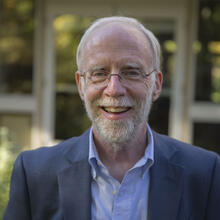Cambridge, MA. Lent is rolling along, but we are also nearing the end of the second chapter of the Yoga Sutras, the chapter I am proposing for our Lenten reflection. Right now we are half way through the “eight limbs” of yoga practice we introduced in our fifith Lenten blog on yoga, last week: restraint, observance, posture, control of breath, letting go, attention, meditation, and indrawal.” Today we handle the middle three, posture, the control of breath, and the in-drawal of the senses.
As a yogic, Lenten practice: sit at ease. Most people, asked about yoga, will immediate think of those very impressive and seemingly impossible positions that extraordinarily agile practitioners, mostly young, undertake. Yet it is striking how little Patanjali says about posture (asana), the third limb of yoga:
“Posture should be steady and with satisfaction, achieved by the relaxation of exertion and by a state of balance without end.” (46-47) That is: sit comfortably in a manner you find pleasing, one that does not require great effort and can be maintained for a long time, “without end.” Lent, I have suggested, might be seen in this same light: as a time to lighten up, loosen one’s burden, let things go, thus reaching a quieter and steady state that one can maintain over time.
The immediate fruits are two: first, “after this, there are no assaults by the opposites” (48) — that is, it seems, one reaches a certain physical and mental steadiness, undisturbed by oppositions such as heat and cold, the pleasant and painful, wealth and poverty, etc. It may seem like a great deal to think that sitting with ease can accomplish this balance, but there is surely more to be said for just sitting quietly than we realize.
The second fruit of easy posture is that one can attend with a certain care and calm to one of those things that we will continue to do: breathing, and this is the fourth limb of yoga. First, we can notice how we actually breath (rather than thinking about how we should breath: “Breath’s movement is external, internal, or stopped; closely measured according to time, place, and number; long or subtle.” (50) With this attention, noticing our breathing patterns, we learn simply to sit and breathe: “After one’s posture is settled, control of breath is cutting back on the motions of in-breath and outbreath.” (49) The result is quite important, since by this breathing, “the covering of light is destroyed, and the mind becomes fit for acts of concentration.” (52-53) We might consider that an excellent Lenten practice, even for its last weeks, would be to sit, and breath, and let that breathing dispel illusions about what and who we are. This removal of the coverings over the light is the removal of bushel basket Jesus warns us again in the Sermon: “No one after lighting a lamp puts it under the bushel basket, but on the lampstand, and it gives light to all in the house” (Matthew 5.17). To sit at ease and attend to our breathing, hiding no longer, will prepare us for the quieter, vulnerable meditations asked of us in Holy Week. As always, less is more.
There is nothing in Patanjali’s rule on breathing that would prevent us from following the third method of prayer recommended by Ignatius in the Exercises: “The Third Method of Prayer is that with each breath in or out, one has to pray mentally, saying one word of the Our Father, or of another prayer which is being recited: so that only one word be said between one breath and another, and while the time from one breath to another lasts, let attention be given chiefly to the meaning of such word, or to the person to whom he recites it, or to his own baseness, or to the difference from such great height to his own so great lowness.” Yet Patanjali might find the words unnecessary, and the pairing of breaths and thoughts unnecessary: just breathe, that is God’s spirit…
As for the fifth limb of yoga, “letting go,” it seems that Patanjali has in mind that if we have reformed our lives (by the first two limbs of yoga), and if we sit quietly and with pleasure and attend to our breathing (in the third and fourth limbs), then the mind naturally lets its thoughts and the senses of their objects come and go, no longer clinging to what we think or see or hear or taste: “When there is no close connection between the mind and its own contents, there is an in-turning of the senses, now as if conformed to that mind’s own inner form.” (54) Again, we may be surprised, by how little is asked of us in order to accomplish so much: the quieted, contented mind, a comfortable seated position, and calmed breathing, together allow us a certain indifference even to our own thoughts — most of which, truth be told, turn out to be not all that urgent. It is this, not the asceticism of the rigorist or romantic, that allows us finally to control the experiences and pulls of our five senses: “Thence arises the highest control of the senses.” (55)
We are almost done with Lent and with Yoga in Lent, and next week we will take up the last three limbs of yoga, most suited to Holy Week: attention, meditation, and indrawal: "So, could you not stay awake with me one hour?" (Matthew 26.40)







